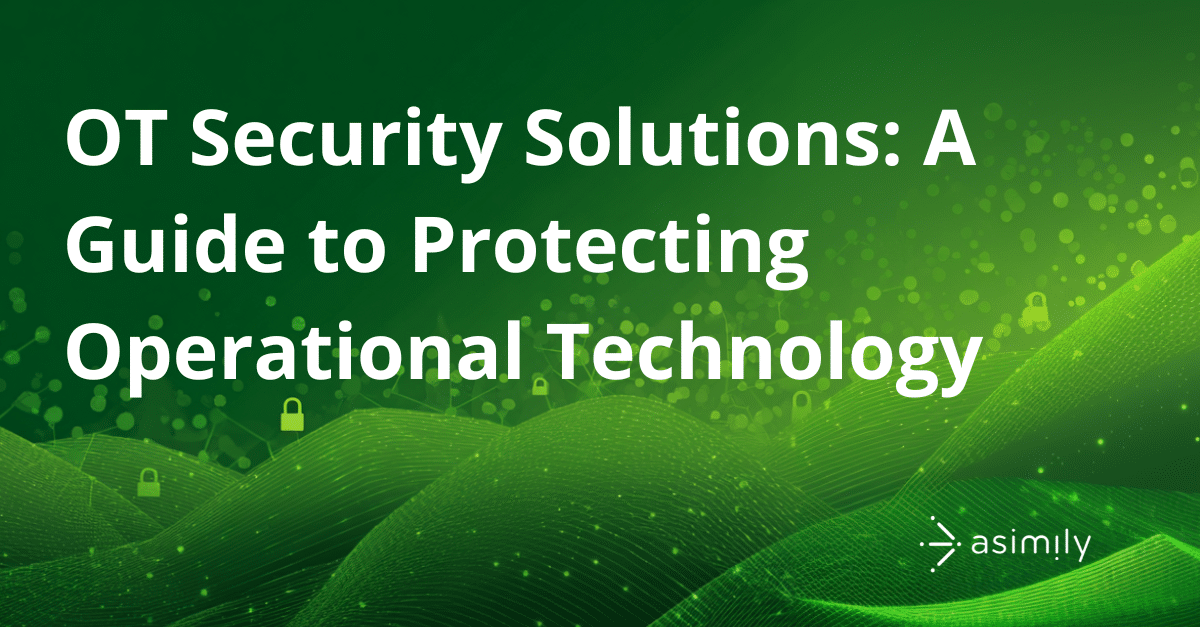OT Security Solutions: A Guide to Protecting Operational Technology

Operational Technology (OT) and Internet of Things (IoT) devices have revolutionized manufacturing and industrial operations, and they also open the door to unique cybersecurity threats that can grind production to a halt. Historically, OT devices were offline and isolated, but modern demands for connectivity have led to these systems merging with traditional IT environments, introducing new vulnerabilities that traditional air-gapping cannot address. To address these security risks, OT security must adapt beyond legacy approaches. Implementing a dedicated OT security solution is crucial for safeguarding critical systems and maintaining operational resilience.
What is Operational Technology (OT) Security?
OT security encompasses protective measures for hardware, software, and devices within an industrial setting. As with other connected devices, OT systems are challenging to secure as they cannot be scanned using traditional tools. This, combined with the convergence of OT and IT systems, has created an expanded attack surface that many organizations struggle to defend. Additional risks stem from remote access capabilities and third-party vendors, which further broaden the potential avenues for cyberattacks.
To mitigate these risks, organizations need to adopt a robust security strategy that includes continuous monitoring and quick vulnerability management. It also requires organizations to have a thorough understanding and inventory of assets so they can effectively identify and mitigate risks in vulnerable devices.
Examples of OT Systems
At the heart of OT security lies the protection of critical infrastructure through systems such as Industrial Control Systems (ICS) and Supervisory Control and Data Acquisition (SCADA). ICS includes a wide range of equipment, like programmable logic controllers (PLCs) and distributed control systems (DCS) that automate industrial processes. SCADA systems, meanwhile, provide centralized monitoring and control of facilities spread across large geographic areas, such as water treatment plants or power grids.
Key Differences Between IT and OT Security
Broadly speaking, IT security focuses on the processing, storage, and transmission of data, while OT security involves managing and securing physical devices and industrial processes. OT systems are predominantly found in industries such as manufacturing, transportation, automation, and healthcare, whereas IT environments generally support office settings, enterprise systems, and data-driven business operations.
A crucial difference between the two is their expected lifecycles. Typically, IT devices such as phones, computers, and tablets are replaced every few years to keep up with evolving technology and security standards. In contrast, OT systems are designed to have much longer lifespans, often prioritizing safety and operational continuity over cybersecurity. As a result, many OT workstations still run end-of-life operating systems, such as Windows XP.
To bolster security and reduce the threat of cyber risks, there has been an increase in regulations aimed at safeguarding critical OT infrastructure. The National Institute of Standards and Technology (NIST) Guide to Operational Technology (OT) Security aims to help organizations secure and protect ICS and other OT assets. Additionally, U.S. Executive Order 14028 underscores the importance of securing critical infrastructure systems, including OT environments, by promoting the adoption of enhanced cybersecurity practices.
Challenges in OT Security
Balancing safety and confidentiality is a central concern in OT security, as these systems support critical, real-time industrial operations. Because these systems lack basic security features, essential processes such as applying patches or firmware updates can be difficult, creating gaps that malicious actors can exploit. Yet, despite the criticality of deploying robust security measures, approximately 70% of organizations investing in OT cybersecurity encounter challenges with implementation, often due to complexities around integrating IT and OT environments.
Vulnerabilities in IT networks can now directly impact OT operations, heightening the risk of production downtime, sabotage, or even safety incidents. Traditional vulnerability scanners and asset inventory tools are often ineffective or disruptive when used on OT or IoT devices, making it harder to identify weaknesses and prioritize remediation efforts.
These factors collectively contribute to a heightened risk of malware, ransomware, and targeted attacks against OT environments, which can severely disrupt operations and critical services. Additionally, remote access, while necessary for vendor maintenance, introduces another layer of exposure by creating pathways for exploit. For example in 2021 a ransomware attack on the Colonial Pipeline saw malicious actors gain entry through a compromised VPN account, disrupting fuel supplies and underscoring how third-party access can become a critical vulnerability in industrial environments.
To mitigate these risks, organizations frequently implement compensating controls such as network segmentation, strict identity and access management, and carefully planned patching schedules. An integrated OT security solution can further strengthen defenses by helping teams address multiple risks through a single platform.
Best Practices for OT Security
Building resilient OT environments requires a proactive security posture. To strengthen their defenses against cyber threats, organizations should consider a layered security approach built on these key practices.
Device Visibility and Monitoring
A foundational first step of any security is to identify all devices on the network and understand their behavior. This can be challenging because many OT environments have a mix of legacy and modern IoT devices. Additionally, scanning OT devices through traditional vulnerability scanners can take these devices offline, causing costly downtime. An OT security solution can help by automatically and safely identifying all devices and maintaining an up-to-date inventory with details such as device time, manufacturer, and firmware version.
In general, connected devices should only communicate with well-known IP addresses and devices in well-understood ways. A security solution can locate, monitor, and flag anomalous behavior from connected devices, enabling teams to investigate potential threats before an attack occurs.
Implement Network Segmentation
Network segmentation limits an organization’s attack surface, reducing the risk of a full-blown cyberattack. Once a threat actor gains access to a network, they typically try to move laterally and gain access to other systems or sensitive information. Segmented networks are used to prevent the spread of malicious activities and enforce strict access controls.
Targeted segmentation divides the device network into smaller networks, making it easier to secure OT and IoT devices based on exploit vectors. Furthermore, segregating access between IT and OT environments is crucial, with restricted and monitored access to OT assets through secure channels.
Vulnerability Mitigation and Remediation
Patching and mitigating vulnerabilities for manufacturers is more complex than in IT environments because many OT environments have a mix of legacy and modern systems. According to NIST IoT security guidance, the lifespan of most systems makes patching operating systems and other known software vulnerabilities complex. Instead, guidance recommends leveraging compensating controls wherever possible.
Manufacturers can leverage an OT solution to utilize industry standards to identify, analyze, and rank critical vulnerabilities, and provide targeted recommendations for vulnerability management by surfacing the simplest actions to reduce risk.
Threat Detection and Incident Response
As with other industries that provide critical services, manufacturing has a low threshold for downtime as it directly impacts revenue and operations. Threat intelligence feeds and continuous monitoring of OT systems allow manufacturers to quickly identify and respond to unusual activities, minimizing the risk of potential attacks and operational disruptions.
An OT solution enhances an organization’s threat detection capabilities by analyzing network traffic to and from all connected devices and alerting on anomalous behavior in real time. Early detection of anomalous behavior can enhance a security team’s ability to respond to an in-progress attack.
Strict Access Controls and Policy Management
Enhancing access control in operational technology environments typically involves implementing multi-factor authentication (MFA) and role-based access control (RBAC) to manage who can access sensitive systems. Limiting access to critical manufacturing devices strictly to authorized personnel is essential. In addition, robust policy management ensures devices operate within predefined constraints and adhere to compliance and industry standards.
Maintaining a snapshot of a connected device’s last known good configuration is also critical. Because many of these devices operate within very specific parameters, configuration drift can be an important indicator of compromise. If routine monitoring detects unexpected changes, an OT security solution can restore the device to its approved state and generate alerts to notify teams of the suspicious activity.
What Makes the Best OT Security Solution?
OT systems require a different cybersecurity approach compared to traditional IT assets. A comprehensive OT security solution should enhance device visibility, offer robust options for device hardening, updating, patching, and monitoring to mitigate the risk of cyber threats and unauthorized access.
A robust security strategy begins with a comprehensive device inventory, enabling organizations to accurately assess the number of connected devices on their network and engage in end-to-end risk management activities. Additionally, OT environments rely on specialized protocols (e.g., Modbus, DNP3, OPC UA) and proprietary systems that differ from those on traditional IT networks. To ensure the device inventory is accurate, the OT solution should be able to quickly parse any communication protocols present on the network.
Under normal circumstances, the patch and update process is cumbersome. Sometimes, there is a mandatory, multi-step update process, such as first updating to an older version before updating to the most current version. An OT security solution helps organizations automate the patching and update process, reducing the risk of security incidents and maintaining the integrity of their environment.
A robust security platform can further enhance device security with more advanced security mechanisms, such as pre-purchase assessments to evaluate device risk and targeted network segmentation.
Asimily: OT Security Solution That’s More Than Just Protection
Cyber threats against OT will continue to evolve, especially as organizations continue to deploy more devices within their environments.
Asimily is a trusted partner for industrial solutions. Our comprehensive platform is designed to meet the unique needs of OT security, such as continuous flow processes and uncommon device protocols. With Asimily, you get targeted protection and continuous monitoring of your entire environment. Asimily’s inventory and vulnerability detection capabilities are built to monitor traffic to and from OT equipment and proactively identify issues.
Interested in learning more? Check out our platform overview.
Secure Every IoT Device.
Automatically.
Cyber threats move fast — so should you. Asimily gives instant inventory and smart, prioritized risk mitigation insights for every IoT, OT, and IoMT device — so you can take action before threats strike.




